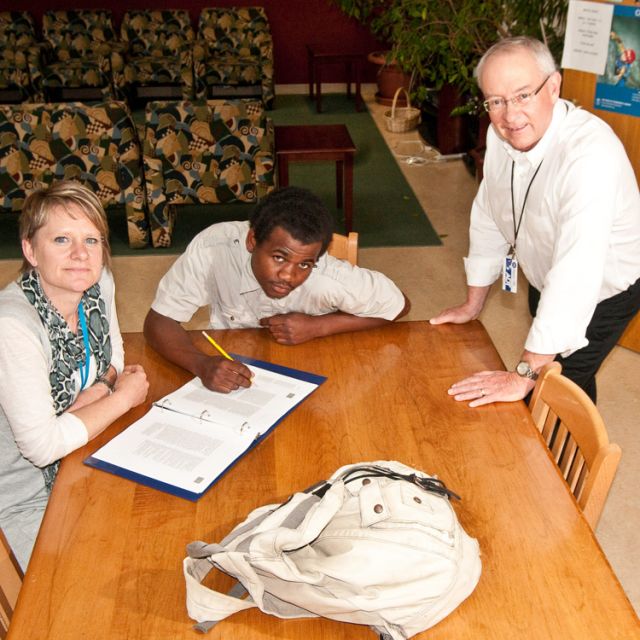At a time when the boomerang generation stays with their families longer, and may then return several times, foster kids are expected to engineer a self-sufficient, independent life at 18 or 21.
“We’re asking some of the most vulnerable youth in the province of Ontario to be on their own at 21 when that’s not what’s happening in communities and homes across the province,” said Bernie Finnigan, Catholic Children’s Aid Society of Toronto manager of child and youth services.
At Covenant House they see the results when foster kids can’t quite navigate the difficult passage into adulthood all by themselves. Up to 40 per cent of the homeless youth who turn up at the downtown Toronto shelter have had some involvement in the child welfare system, with one in four having been foster kids.
For the last decade Covenant House has offered a transitional year focussed on life skills in a college dorm-like setting. The program is called Rites of Passage and works with kids 18 to 25 years old. Covenant House also teams up with Catholic Children’s Aid to help kids through a program called Transitions, which pairs a kid with a social worker who is there any time, day or night, to encourage, advise, warn and suggest.
“The kind of structure and focus we provide is just what these young people need,” said Covenant House executive director Bruce Rivers. “And that they’ve not necessarily received in their experience within the child welfare system.”
Catholic Children’s Aid already skirts the provincial rules by allowing kids who turn 18 before they graduate from high school to stay in their foster homes until they graduate. The province cuts off funding the minute the high school student turns 18, but Catholic Children’s Aid steps in and replaces that funding for approximately 20 youth per year whose birthday falls before graduation day.
“A good parent would not ask their child to leave home at the age of 18. So we’ve extended funding, allowing children to stay in their foster homes beyond 18 if they’re still in high school,” said Finnigan. “And we’re not funded for that.”
Even kids who are in college or university programs find it difficult under the current system to complete their education because the bare minimum, $1,000-per-month stipend they were getting disappears the day they turn 21. They can apply for loans, but watching debts pile up when there’s no family to backstop them is a frightening prospect and many drop out.
“If that (stipend) allows them to stay in school and complete their college or university, I think it’s a small price to pay,” said Finnigan.
“Extending the age for eligibility up to 25 is absolutely critical,” said Rivers.
If the province wants to be sure money going to older foster kids is being constructively used, adopting the Rites of Passage model could give them that confidence, said Rivers.
“This kind of an approach has huge merit and would do well in other parts of the province.”
Whatever system Ontario ends up with, the province has to remember that young people are young.
“Our experience is of many of the young people coming to us multiple times before they’re ready to focus in the way that they need to,” said Rivers. “Current rules are such that if a young person opts out before their 21st birthday they’re out, that’s it.”
“We’re all aware we face a major deficit right now,” said Finnigan. “However, to short-change our youth — and I want to call them ‘our youth’ — to short-change them is not the way to deal with it. It’s really shortsighted in terms of the gains.”
Youth in Care - the facts
- Ontario has about 8,300 crown wards plus another 8,500 children in the temporary care of a children's aid society. About one million Canadians have been cared for by the state at some point in their lives. Right now, about 17,000 of Ontario's 3.1 million children are in the care of the state.
- 68 per cent of homeless youth come from either foster care or a group home.
- Former youth in care wind up in jail at about five times the Ontario incarceration rate of 0.9 per cent.
- Only 44 per cent of foster kids complete high school by age 18, compared with a provincial average of 81 per cent.
- At age 18 a child in foster care automatically must move out of the foster home. If not in school, 18-year-olds lose all support. Foster kids who stay in school lose their support at 21. Foster students who drop out of school but later decide to resume their education cannot regain the benefits they lost.
- It costs $45,000 per year to keep a kid in foster care.
- Extending the age of eligibility to 25 for all foster kids still in school would cost $26 million per year.
- The Office of the Provincial Advocate estimates the province could save $132 million over 40 years in everything from health care to incarceration costs to extra tax revenue from former foster children who are better employed and earning higher incomes. The Provincial Advocate's cost-benefit analysis shows the province saving $1.36 for every $1 spent extending benefits to children up to 25.

